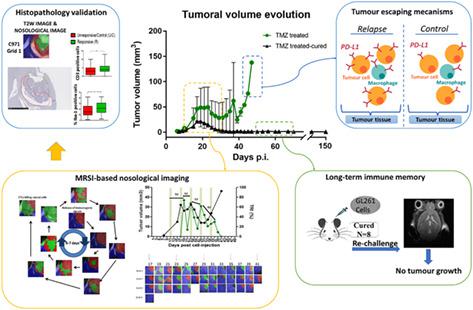当前位置:
X-MOL 学术
›
NMR Biomed.
›
论文详情
Our official English website, www.x-mol.net, welcomes your feedback! (Note: you will need to create a separate account there.)
Anti-tumour immune response in GL261 glioblastoma generated by Temozolomide Immune-Enhancing Metronomic Schedule monitored with MRSI-based nosological images.
NMR in Biomedicine ( IF 2.9 ) Pub Date : 2020-01-11 , DOI: 10.1002/nbm.4229 Shuang Wu 1 , Pilar Calero-Pérez 1, 2 , Lucia Villamañan 1 , Nuria Arias-Ramos 1, 2 , Martí Pumarola 2, 3 , Sandra Ortega-Martorell 4 , Margarida Julià-Sapé 1, 2, 5 , Carles Arús 1, 2, 5 , Ana Paula Candiota 1, 2, 5
NMR in Biomedicine ( IF 2.9 ) Pub Date : 2020-01-11 , DOI: 10.1002/nbm.4229 Shuang Wu 1 , Pilar Calero-Pérez 1, 2 , Lucia Villamañan 1 , Nuria Arias-Ramos 1, 2 , Martí Pumarola 2, 3 , Sandra Ortega-Martorell 4 , Margarida Julià-Sapé 1, 2, 5 , Carles Arús 1, 2, 5 , Ana Paula Candiota 1, 2, 5
Affiliation

|
Glioblastomas (GB) are brain tumours with poor prognosis even after aggressive therapy. Improvements in both therapeutic and follow-up strategies are urgently needed. In previous work we described an oscillatory pattern of response to Temozolomide (TMZ) using a standard administration protocol, detected through MRSI-based machine learning approaches. In the present work, we have introduced the Immune-Enhancing Metronomic Schedule (IMS) with an every 6-d TMZ administration at 60 mg/kg and investigated the consistence of such oscillatory behaviour. A total of n = 17 GL261 GB tumour-bearing C57BL/6j mice were studied with MRI/MRSI every 2 d, and the oscillatory behaviour (6.2 ± 1.5 d period from the TMZ administration day) was confirmed during response. Furthermore, IMS-TMZ produced significant improvement in mice survival (22.5 ± 3.0 d for controls vs 135.8 ± 78.2 for TMZ-treated), outperforming standard TMZ treatment. Histopathological correlation was investigated in selected tumour samples (n = 6) analyzing control and responding fields. Significant differences were found for CD3+ cells (lymphocytes, 3.3 ± 2.5 vs 4.8 ± 2.9, respectively) and Iba-1 immunostained area (microglia/macrophages, 16.8% ± 9.7% and 21.9% ± 11.4%, respectively). Unexpectedly, during IMS-TMZ treatment, tumours from some mice (n = 6) fully regressed and remained undetectable without further treatment for 1 mo. These animals were considered "cured" and a GL261 re-challenge experiment performed, with no tumour reappearance in five out of six cases. Heterogeneous therapy response outcomes were detected in tumour-bearing mice, and a selected group was investigated (n = 3 non-responders, n = 6 relapsing tumours, n = 3 controls). PD-L1 content was found ca. 3-fold increased in the relapsing group when comparing with control and non-responding groups, suggesting that increased lymphocyte inhibition could be associated to IMS-TMZ failure. Overall, data suggest that host immune response has a relevant role in therapy response/escape in GL261 tumours under IMS-TMZ therapy. This is associated to changes in the metabolomics pattern, oscillating every 6 d, in agreement with immune cycle length, which is being sampled by MRSI-derived nosological images.
中文翻译:

通过基于MRSI的疾病影像学监测的替莫唑胺增强免疫节律计划产生的GL261胶质母细胞瘤中的抗肿瘤免疫反应。
胶质母细胞瘤(GB)是即使经过积极治疗也预后较差的脑肿瘤。迫切需要改善治疗和随访策略。在以前的工作中,我们描述了使用基于MRSI的机器学习方法检测到的使用标准给药方案对替莫唑胺(TMZ)的响应的振荡模式。在目前的工作中,我们以60 mg / kg的剂量每6 d TMZ引入了一种免疫增强节拍方案(IMS),并研究了这种振荡行为的一致性。每隔2 d用MRI / MRSI研究n = 17只GL261 GB荷瘤的C57BL / 6j小鼠,并在应答期间确认其振荡行为(从TMZ给药日起6.2±1.5 d)。此外,IMS-TMZ显着提高了小鼠的存活率(22.5±3)。对照组为0 d,TMZ处理为135.8±78.2),优于标准TMZ处理。在选定的肿瘤样本(n = 6)中研究组织病理学相关性,分析对照和反应场。发现CD3 +细胞(淋巴细胞分别为3.3±2.5 vs 4.8±2.9)和Iba-1免疫染色区域(小胶质细胞/巨噬细胞分别为16.8%±9.7%和21.9%±11.4%)存在显着差异。出乎意料的是,在IMS-TMZ治疗期间,某些小鼠(n = 6)的肿瘤完全消退,并且未经进一步治疗1个月仍无法检测到。这些动物被认为是“治愈的”,并且进行了GL261再挑战实验,在六分之五的病例中没有肿瘤再出现。检测了荷瘤小鼠的异质治疗反应结果,并调查了一个选定的组(n = 3个无反应者,n = 6个复发性肿瘤,n = 3个对照)。大约发现PD-L1含量。与对照组和非应答组相比,复发组增加了3倍,表明淋巴细胞抑制作用增加可能与IMS-TMZ失败有关。总体而言,数据表明宿主免疫应答在IMS-TMZ治疗下对GL261肿瘤的治疗应答/逃逸中具有相关作用。这与代谢组学模式的变化有关,该变化每6 d振荡一次,与免疫周期的长度一致,该免疫周期的长度已由MRSI衍生的疾病影像进行采样。数据表明,在IMS-TMZ治疗下,宿主免疫应答在GL261肿瘤的治疗应答/逃逸中具有重要作用。这与代谢组学模式的变化有关,该变化每6 d振荡一次,与免疫周期的长度一致,该免疫周期的长度已由MRSI衍生的疾病影像进行采样。数据表明,在IMS-TMZ治疗下,宿主免疫应答在GL261肿瘤的治疗应答/逃逸中具有重要作用。这与代谢组学模式的变化有关,该变化每6 d振荡一次,与免疫周期的长度一致,该免疫周期的长度已由MRSI衍生的疾病影像进行采样。
更新日期:2020-03-09
中文翻译:

通过基于MRSI的疾病影像学监测的替莫唑胺增强免疫节律计划产生的GL261胶质母细胞瘤中的抗肿瘤免疫反应。
胶质母细胞瘤(GB)是即使经过积极治疗也预后较差的脑肿瘤。迫切需要改善治疗和随访策略。在以前的工作中,我们描述了使用基于MRSI的机器学习方法检测到的使用标准给药方案对替莫唑胺(TMZ)的响应的振荡模式。在目前的工作中,我们以60 mg / kg的剂量每6 d TMZ引入了一种免疫增强节拍方案(IMS),并研究了这种振荡行为的一致性。每隔2 d用MRI / MRSI研究n = 17只GL261 GB荷瘤的C57BL / 6j小鼠,并在应答期间确认其振荡行为(从TMZ给药日起6.2±1.5 d)。此外,IMS-TMZ显着提高了小鼠的存活率(22.5±3)。对照组为0 d,TMZ处理为135.8±78.2),优于标准TMZ处理。在选定的肿瘤样本(n = 6)中研究组织病理学相关性,分析对照和反应场。发现CD3 +细胞(淋巴细胞分别为3.3±2.5 vs 4.8±2.9)和Iba-1免疫染色区域(小胶质细胞/巨噬细胞分别为16.8%±9.7%和21.9%±11.4%)存在显着差异。出乎意料的是,在IMS-TMZ治疗期间,某些小鼠(n = 6)的肿瘤完全消退,并且未经进一步治疗1个月仍无法检测到。这些动物被认为是“治愈的”,并且进行了GL261再挑战实验,在六分之五的病例中没有肿瘤再出现。检测了荷瘤小鼠的异质治疗反应结果,并调查了一个选定的组(n = 3个无反应者,n = 6个复发性肿瘤,n = 3个对照)。大约发现PD-L1含量。与对照组和非应答组相比,复发组增加了3倍,表明淋巴细胞抑制作用增加可能与IMS-TMZ失败有关。总体而言,数据表明宿主免疫应答在IMS-TMZ治疗下对GL261肿瘤的治疗应答/逃逸中具有相关作用。这与代谢组学模式的变化有关,该变化每6 d振荡一次,与免疫周期的长度一致,该免疫周期的长度已由MRSI衍生的疾病影像进行采样。数据表明,在IMS-TMZ治疗下,宿主免疫应答在GL261肿瘤的治疗应答/逃逸中具有重要作用。这与代谢组学模式的变化有关,该变化每6 d振荡一次,与免疫周期的长度一致,该免疫周期的长度已由MRSI衍生的疾病影像进行采样。数据表明,在IMS-TMZ治疗下,宿主免疫应答在GL261肿瘤的治疗应答/逃逸中具有重要作用。这与代谢组学模式的变化有关,该变化每6 d振荡一次,与免疫周期的长度一致,该免疫周期的长度已由MRSI衍生的疾病影像进行采样。

























 京公网安备 11010802027423号
京公网安备 11010802027423号